
18 minute read
TV/STREAMING: WATCHMEN
WATCHMEN’S LEGACY: NEXT-LEVEL CINEMATIC TV VFX
By TREVOR HOGG
TOP: YouTube footage of pig races was an important reference for Mackevision when putting together the court scene. (Image courtesy of Mackevision and HBO)
OPPOSITE TOP: It was important for Framestore to make the experience of the energy being sucked out of Doctor Manhattan as visceral and painful as possible. (Image courtesy of Framestore and HBO)
OPPOSITE BOTTOM: Creator Damon Lindelof on set with Regina King while shooting the HBO limited series adaptation of Watchmen. (Image courtesy of HBO) As with the original 1986-1987 comic book maxi-series conceived by Alan Moore and Dave Gibbons, the HBO production of Watchmen was treated as a limited series by creator Damon Lindelof. The alternative history drama begins with the Tulsa Race Massacre of 1921 and then focuses on a white supremacist group known as the Seventh Kavalry violently opposing the Tulsa Police Department in the present.
The story ambitions are epic and at times surreal, whether it be frozen squids raining down from the sky, clones being catapulted, a mirror-reflecting mask or a super-powerful blue being. The workload was shared among 30 vendors under the direction of Visual Effects Supervisor Erik Henry and Visual Effects Producer Matt Robken, who previously collaborated on Tom Clancy’s Jack Ryan. Among those recruited by Henry and Robken were Hybride, Rodeo FX, Raynault VFX, Mackevision, BUF, The Mill, Important Looking Pirates, MARZ, One Of Us and Framestore, with artists situated in Paris, Stuttgart, London, Montreal, Toronto and Stockholm.
A tight production schedule led to the decision to have a roster of visual effects vendors that would rival a Marvel Studios movie. “It was going to be tough to deliver the last three episodes, so we made sure that no one had too many shots at one time to avoid having a logjam at the end,” states Henry. “The scripts came close to the time we had to shoot, which meant not a lot of prep time. Way before the scripts came to the crew, we would be given a verbal description of what the big scenes were and in that way were able to do previs in some instances and certainly build models in advance. All that prep work helped us get to the finish line.” An important element of the visual effects process was having a quick editorial turnover. “We talked to Damon, the directors and editors, and requested that they lock the visual effects sequences early,”
“It was going to be tough to deliver the last three episodes, so we made sure that no one had too many shots at one time to avoid having a logjam at the end. The scripts came close to the time we had to shoot, which meant not a lot of prep time. Way before the scripts came to the crew, we would be given a verbal description of what the big scenes were and in that way were able to do previs in some instances and certainly build models in advance. All that prep work helped us get to the finish line.” —Erik Henry, Visual Effects Supervisor

remarks Robken. “You can throw as much acceleration money at it as you can but there is only so much time in a day. Everyone was great about it.”
Critical to the project were the design of Doctor Manhattan (Yahya Abdul-Mateen II), the Millennium Clock and the reflective mask worn by Detective Wade Tillman/Looking Glass (Tim Blake Nelson). “I discussed with Damon whether Doctor Manhattan should glow all of the time and decided it should only happen when he was using his powers,” states Henry. “We also wanted to make sure that the performance of the actor came through. The Millennium Clock took a lot of time and had to be like a Trojan horse. We had to have it look like it could tell time in some strange atomic clock way but [in reality] be a machine that could trap Doctor Manhattan. As for the silver shiny mask that Looking Glass wore, I came up with the idea that cameras would be needed on the head of the actor because there was no real way to get production to shoot everything twice.”
Approximately 2,600 visual effects were produced with the range for each of the nine episodes going from 500 to 150. “HBO came in with a great attitude and knew what it was going to take to put these scripts onscreen,” states Robken. “Our budget was always hefty and appropriate. There was some contingency money that


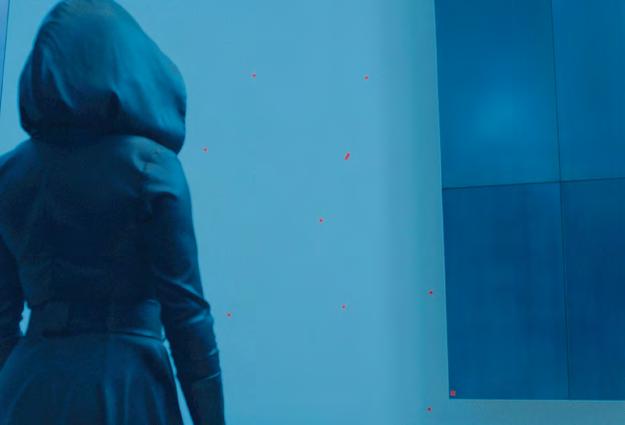

we used. We had a big visual effects team [with a staff membership of 16] on Watchmen, which helped us get through so many vendors, and developed a good pipeline and workflow. We had an on-set supervisor, data wrangler and a visual effects editorial team for odds and evens [blocks of episodes] until later in the season when we ramped down to one.” Assets and shots needed to be shared. “There were legacy effects like the squid where it was a one-off scene that we gave to Hybride, and later in the season they showed up again but were mixed into either set or situations that other vendors had already done. There were quite a number of shared shots and that was an added challenge later in season.”
The effects work varied from episode to episode, which meant that Hybride did not have reoccurring assets. “The most technically advanced sequence that we worked on was the squid rain,” states Mathieu Boucher, Executive Producer and Director of Production. “Small squids are falling from the sky and start to melt upon getting into the atmosphere. To have a creature that is super soft and rubbery hit a surface and after a few seconds

start to melt is a worse scenario in CG because you have soft body deformations and fluid dynamics. There are millions of squids interacting with an environment. We created libraries of splashes and melting squids, pre-cached those and reassembled them in a final simulation. One of the most useful references was a hailstorm that we found for how millions of falling objects bounce and create multiple layers. You see a wavy pattern in the background which helps with scale. The fluid created by frogs reproducing was a point of reference for close-up shots. You have to be creative and find stuff that connects with what you’re trying to achieve and grounds it into a realistic setting.”
Episode 6, which was done in black and white, features a major contribution from Rodeo FX. “The biggest shot we had was when Hooded Justice (Jovan Adepo) is fighting inside a grocery store. There’s lettuce and cereal exploding, he jumps through a window, time completely freezes, and we do a full 180 degrees around him,” remarks Thomas Montminy Brodeur, Visual Effects Supervisor. “It was one continuous shot that had four different cameras, three
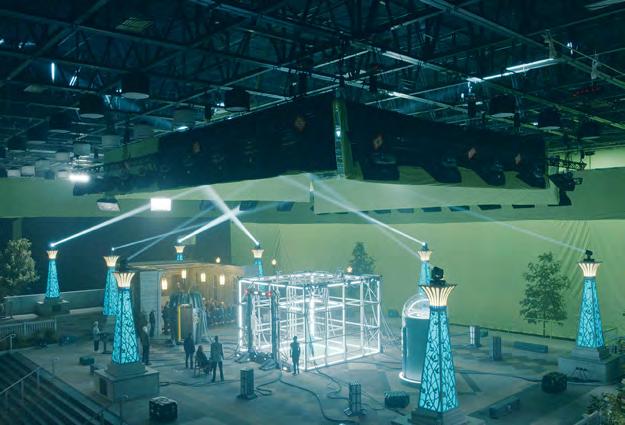


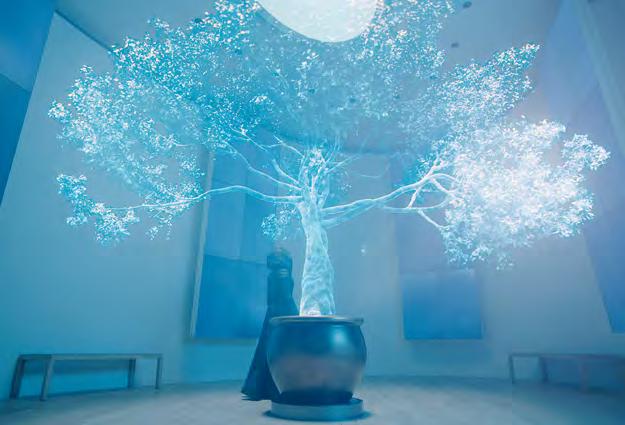
“The biggest difficulty with visual effects that aren’t ordinary is to make them photoreal, because sometimes the mind doesn’t even know what that looks like.” —Matt Robken, Visual Effects Producer
witness cameras, a digital double, and the whole environment outside had to be recreated so it matched with how the camera turns around. That took six months to create. We decided to film without a cape, cereal and lettuce to control the timing. Parallax was needed for the lettuce, cereal and glass while the camera is traveling to avoid them looking like 2D elements. A LiDAR scan was taken of the grocery store.” The handheld camera complicated the stitching of the plates. “One plate will go fast and the other slow, so you need to create a stitch that will be an average between those two to maintain the rhythm of the episode. The best thing for us was when a transition could occur when the actor was out of frame.”
Raynault produced a 1,498 frame shot that goes from a massacre
OPPOSITE TOP AND BOTTOM LEFT: Markers guide the eyeline for Sister Night (Regina King) for the computer graphics later produced by BUF. (Images courtesy of BUF and HBO)
OPPOSITE TOP AND BOTTOM RIGHT: BUF designed the holograms to track museum patrons as they walk by them. (Images courtesy of BUF and HBO)
TOP AND BOTTOM LEFT: BUF transforms a greenscreen stage into a nighttime environment. (Images courtesy of BUF and HBO)
TOP AND BOTTOM RIGHT: The holographic tree created by BUF combined realistic and graphic elements. (Images courtesy of BUF and HBO)



at a carnival in Hoboken, New Jersey to a giant squid being teleported in Manhattan by Adrian Veidt. “I went to New York City with a drone pilot to gather reference of the Hudson River,” states Mathieu Raynault, Founder. “In the end the only plate we used was the one in the beginning. A small town in Georgia was used for Hoboken. We took some liberty to change the sky and bring in some light so it wasn’t pitch black. The river was the natural dividing line. Hoboken required set extensions and creating corpses on the ground and cars. There are still burgers cooking on the barbeque. Before you get to the Ferris wheel the shot is entirely CG. Then you see the piers and start crossing the river. The audience doesn’t know where they are at that point.” Several blocks in New York City were photographed to provide reference material for the modelers. “The squid was a sculpture because it’s not moving. We had to find that right shape so it feels dead on the building with those tentacles. A lot of liberties were taken with one tentacle being a kilometer long.”
Watchmen was the first superhero project for Mackevision,

which joined after principal photography was completed. “The pigs were our toughest sequence because bringing full CG creatures to life is already a challenge in itself,” states Emanuel Fuchs, Visual Effects Supervisor. “We found a perfect reference on YouTube where a German farmer has pig races and surprisingly had the same sizes of the pigs we were looking for – he opened the wood board and the pigs started to run. That was all that we needed for our shot when the door of the courtroom was opened and the pigs started to run. We stabilized the footage because it was handheld and all over the place, tracked it into our shots, gave that as a reference to the animators and showed it to Erik. We talked about, do they start immediately with the run cycle or canter first, go faster and become slower again? We had a project with pigs before, so we had our muscles system setup. We did some tweaks because before we only had one character and with this we were up to 30 characters.”
BUF was responsible for designing, creating and executing the holograms in the museum situated in the Greenwood Center for

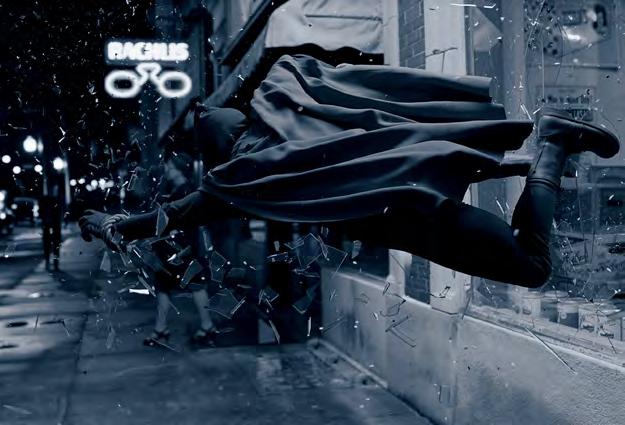


“There was a storyboard animatic of the kinds of things that they wanted in the sequence [of Doctor Manhattan terraforming Europa], but it was left to us to figure out how to navigate telling the story. There was a clear brief from Damon and Erik that they didn’t want us to animate or have anything that moved and looked like time-lapse photography. These events needed to appear sped up, not captured over a long duration.” —Tom Luff, Visual Effects Supervisor OPPOSITE TOP AND BOTTOM LEFT: The hologram shoot conducted by BUF occurred after principal photography had been completed. (Images courtesy of BUF and HBO) Cultural Heritage which is visited by Angela Abar/Sister Night (Regina King). “We had major constraints because the plates OPPOSITE TOP AND BOTTOM RIGHT: BUF created a flashlight beam that flickers like a projector for a black were shot without any actors on the podiums,” states Olivier and white sequence. (Images courtesy of BUF and HBO) Cauwet, Visual Effects Supervisor. “They requested us to add some TOP AND BOTTOM LEFT: The hardest effect for Rodeo FX was holograms many weeks after that, so there was no possibility to constructing a seamless, continuous shot that concludes with reshoot some actors at the same angles. One day was devoted to Hooded Justice (Jovan Adepo) leaping through a storefront window. (Images courtesy of Rodeo FX and HBO) shooting holograms with 12 cameras on a greenscreen set. For some shots we didn’t know the perspective, focus and lens. It’s a TOP AND BOTTOM RIGHT: BUF treated the imagery as if it was shot on old and degraded black and white film. 3D model with projection from 12 cameras. The hologram is made (Images courtesy of BUF and HBO)

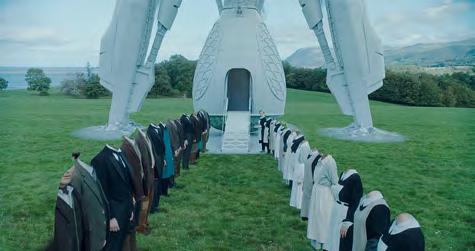

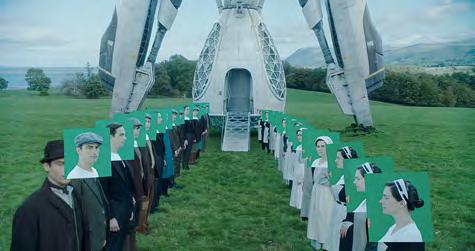
TOP TO BOTTOM: Important Looking Pirates tracked the faces in the plate elements, lined them up with the CG heads of Mr. Phillips (Tom Mison) and Ms. Crookshanks (Sara Vickers), and re-lighted the faces to make them a closer match to the main plate. (Images courtesy of ILP and HBO) of particles, like pixels in 3D, so you can match to the lens and camera movement.” The holograms have the ability to interact with patrons. “When a person enters the museum and comes close to a hologram, the idea was that it would light on,” remarks Justine Paynat-Sautivet, Visual Effects Producer. “If a person is turning around at a podium, the hologram would turn and talk to them.”
The Mill looked after a variety of different shots such as Doctor Manhattan terraforming Europa. “It was an ambitious sequence as we had to tell the story of Doctor Manhattan building this biodome on the surface of Europa in about 60 seconds,” notes Tom Luff, Visual Effects Supervisor. “There was a lot of detail that we wanted to get in there to show the scale of what he was doing from the large to small. We wanted to show these iceberg forms cracking and sheering off and gas being released from inside of the planet, as well cutting to shots of seeds unfurling and plants starting to come out of the ground. There was a storyboard animatic of the kinds of things that they wanted in the sequence, but it was left to us to figure out how to navigate telling the story. There was a clear brief from Damon and Erik that they didn’t want us to animate or have anything that moved and looked like time-lapse photography. These events needed to appear sped up, not captured over a long duration. We had to remove the jittery animation where the camera has moved slightly into position each time a photo has been taken and keep a constant lighting condition rather than having a sun moving over the horizon.”
For Important Looking Pirates, the face replacements for the cloned servants of Adrian Veidt (Jeremy Irons) on Europa were the trickiest assets to execute. “Using plate elements or combining them with our CG heads was the most effective,” states Bobo Skipper, Visual Effects Supervisor. “We used a variety of techniques on a shot-by-shot basis in order to integrate the elements with the plate. We of course did a lot of projecting, intricate grading and masking in comp. In some cases, we tracked the faces in the plate elements [that were shot on greenscreen] and lined them up with our CG head so we could combine the plate with the CG and essentially re-light the faces to make them closer match the main plate. For wider shots our CG assets worked quite well, for close ups we relied more on plates, and in some cases a mix of the two was the way to go.” ILP shared 57 out of 138 shots with other vendors. “Given our successful work with the face replacements, we agreed with the client that we would focus our efforts on that job for several shots,” remarks Kajsa Kurtén, Visual Effects Production Manager, “while the rest of the shot work and final comp was handled by another vendor.”
A complicated effect handled by MARZ was the reflective face mask worn by Detective Wade Tillman/Looking Glass that appears in over 300 shots. “Erik’s main concern was how we went about capturing all of the reflection data,” remarks Nathaniel Larouche, Visual Effects Supervisor. “There was a 360 Rylo camera on the front and back of Tim’s head and both captured 6K spherical video. The camera had an internal
accelerometer gyroscope and recorded the rotation information into the MP4 file. We did a scan of his face clean, with a few different FACS, and wearing the mask, as it’s interesting how it presses his nose down. We came up with a process of being able to bring back and mimic some of the folds in the footage.”
Doctor Manhattan gets destroyed by Framestore in the final episode. “Erik described it as, ‘There are these evil people who switch on a beam that hits Doctor Manhattan like a hammer and sucks out his energy. This is visceral and really painful.’” states Ahmed Gharraph, Visual Effects Supervisor. “He didn’t want his physical body to disintegrate. It was just pure energy. We spent a week or two doing a bunch of concept art.” A still frame was taken from the plate photography and painted over. “There was a cage built and a spotlight shining down on the actor. We had to give the beam of light some volume but didn’t want to overwhelm the image, as it was important to see Doctor Manhattan acting alongside his co-star. It’s a heartfelt moment between those two characters. There was only one shot where we used a digital double. We tried different types of simulations and ended up with a nice mixture of particles, liquids and volumetrics. It was a Houdini workflow. Once it goes into Nuke you have infinite control over the passes and compositing the layers on top of each other. There was a lot of back and forth in terms of adjusting viscosity to make sure it looks like the stuff is actually peeling off of his skin.”
Of the over 100 shots created by One Of Us, the scene that caused them the most sleepless nights was the de-materialization of Doctor Manhattan by the portal gun. “There were conceptual constraints,” notes Dominic Parker, Co-director at One Of Us. “The effect had to be a variant on the teleportation we had seen earlier in the series, but where the previous one had been a planar surface, this had to be shot out of a gun. And it had to fit a specific performance. We took this shot to the wire. If the wire had been a couple of weeks later, then we’d have probably taken it to the wire.” A 3D scan of Doctor Manhattan was provided to One Of Us. “From a design perspective, the unusual thing about Watchmen was that it was not always looking for a cool, slick aesthetic. The whole look of the production was a little off-kilter and difficult to define.”
The effort of the entire production team garnered critical and public acclaim, with Watchmen being lauded with a Peabody Award. “The biggest difficulty with visual effects that aren’t ordinary is to make them photoreal, because sometimes the mind doesn’t even know what that looks like,” observes Robken. “It’s daunting in that way, but at the same time the variety of challenges thrown at us kept it fun, interesting, and let us explore.” Henry laughs, “I will confess that when I first read that squids would be falling from the sky, I had a WTF moment! The reflective mask and the whole finale with the powers of Doctor Manhattan being taken away were gratifying. You see Doctor Manhattan force away what is happening to him. Sister Night asks, ‘Where are you?’ He says, ‘I’m in every moment.’ The way he says it and the effects around him are moving in slow motion, that’s the power of the show. It can be spectacle on an amazing level, and yet every time I think about that scene, I get teary-eyed. I’m glad to be part of those moments.”

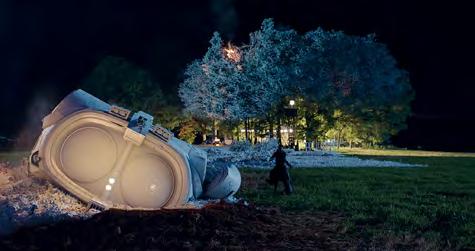

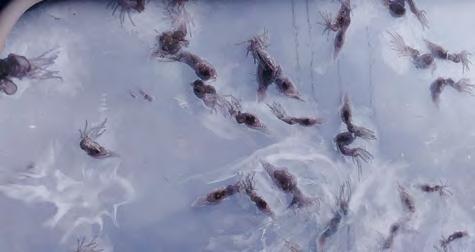

TOP THREE: Plate, grey scale and final composite of the Nite Owl crashing by Important Looking Pirates. (Images courtesy of ILP and HBO)
BOTTOM TWO: The most technically advanced sequence that Hybride worked on was the squid rain. (Images courtesy of Hybride and HBO)










